Influence of Aluminum on Fatigue Strength of Solution-Strengthened Nodular Cast Iron
Abstract
1. Introduction
2. Materials and Methods
2.1. Casting
2.2. Specimen Analyses
2.3. Fatigue Tests
3. Results
3.1. Influence of Aluminum on Silicon Segregation
3.2. Fatigue Tests
3.3. Root Cause Analysis
3.3.1. Fractography
3.3.2. Graphite Morphology
3.3.3. Electron Backscatter Diffraction Measurements (EBSD)
4. Discussion and Conclusions
- Adding 0.18 wt.% Al to a high silicon-alloyed nodular cast iron resulted in a significantly higher fatigue strength based on the 50% failure probability. This positive effect was diminished by the increased scatter of the fatigue endurance limit of alloy A1.
- The aluminum affects several constituents of the microstructure including the graphite and orientation of ferrite grains.
- The fatigue strength of high silicon-alloyed nodular cast iron can possibly be specifically adjusted by the addition of aluminum. To achieve this, more alloys with aluminum contents between 0.0 wt.% and about 0.2 wt.% Al must be investigated.
- Investigation of the influence of adding aluminum to high silicon-alloyed nodular cast iron on mold filling.
- Systematic investigation of the influence of aluminum on texture formation in ferrite.
Author Contributions
Funding
Institutional Review Board Statement
Informed Consent Statement
Data Availability Statement
Conflicts of Interest
Appendix A
| Specimen | Crack Locus | √ Area [µm] | √ Sum Area [µm] |
|---|---|---|---|
| 1_1 | Micro shrinkage | 101.8 | - |
| - | Micro shrinkage | 72.2 | - |
| - | Micro shrinkage | 65.6 | 141.0 |
| 1_3 | Micro shrinkage | 39.8 | - |
| - | Graphite | 34.9 | 52.9 |
| 1_6 | Micro shrinkage | 82.8 | 82.8 |
| 1_8 | Micro shrinkage | 122.7 | - |
| - | Micro shrinkage | 72.7 | 142.6 |
| 1_11 | Micro shrinkage | 106.9 | 106.9 |
| 1_13 | Graphite | 99.6 | 99.6 |
| 1_15 | Micro shrinkage | 107.5 | 107.5 |
| 1_17 | Micro shrinkage | 77.8 | 77.8 |
| 1_19 | Micro shrinkage | 109.3 | 109.3 |
| Specimen | Crack Locus | √ Area [µm] | √ Sum Area [µm] |
|---|---|---|---|
| 2_8 | Graphite | 50.3 | - |
| - | Graphite | 79.7 | - |
| - | Graphite | 74.3 | - |
| - | Graphite | 67.4 | - |
| - | Graphite | 53.3 | 147.6 |
| 2_10 | Graphite | 73.3 | - |
| - | Graphite | 58.2 | 93.6 |
| 2_11 | Graphite | 100.8 | 100.8 |
| 2_12 | Graphite | 45.1 | - |
| - | Graphite | 65.1 | - |
| - | Graphite | 104.7 | - |
| - | Graphite | 85.0 | - |
| - | Graphite | 47.8 | 163.5 |
| 2_13 | Graphite | 102.1 | 102.1 |
| 2_16 | Graphite | 74.2 | 74.2 |
| 2_18 | Graphite | 74.4 | - |
| - | Graphite | 81.3 | 110.9 |
| 2_23 | Graphite | 160.4 | 160.4 |
| Specimen | Crack Locus | √ Area [µm] | √ Sum Area [µm] |
|---|---|---|---|
| 3_4 | Graphite | 124.5 | 124.5 |
| 3_5 | Micro shrinkage | 135.4 | - |
| - | Micro shrinkage | 121.2 | 181.7 |
| 3_10 | Graphite | 67.1 | - |
| - | Graphite | 91.7 | - |
| - | Graphite | 46.3 | 122.7 |
| 3_12 | Graphite | 123.4 | - |
| - | Graphite | 40.0 | 129.7 |
| 3_11 | Micro shrinkage | 129.6 | 129.6 |
| 3_13 | Graphite | 102.6 | - |
| - | Micro shrinkage | 39.3 | 109.8 |
| 3_18 | Micro shrinkage | 117.1 | 117.1 |
| 3_22 | Graphite | 115.0 | - |
| - | Graphite | 73.2 | - |
| - | Graphite | 34.0 | - |
| - | Graphite | 68.3 | - |
| - | Graphite | 61.3 | 167.8 |
| Step No. | Sandpaper Grit/ Polishing Grit | Grinding Force [N] | Time [min:s] |
|---|---|---|---|
| 1 | 80 | 25 | 2:00 |
| 2 | 180 | 25 | 2:00 |
| 3 | 320 | 25 | 2:00 |
| 4 | 500 | 25 | 2:00 |
| 5 | 1000 | 20 | 3:00 |
| 6 | 9 µm | 25 | 4:00 |
| 7 | 3 µm | 25 | 4:00 |
| 8 | 0.25 µm | 30 | 6:00 |
References
- Shirani, M.; Härkegård, G. Casting defects and fatigue behaviour of ductile cast iron for wind turbine components: A comprehensive study. Mater. Werkst. 2011, 42, 1059–1074. [Google Scholar] [CrossRef]
- Vaško, A. Evaluation of shape of graphite particles in cast irons by a shape factor. Mater. Today Proc. 2016, 3, 1199–1204. [Google Scholar] [CrossRef]
- Endo, M.; Matsuo, T. A practical method for fatigue limit prediction in ductile cast irons. Fatigue Fract. Eng. Mater. Struct. 2019, 211, 628. [Google Scholar] [CrossRef]
- European Committee for Standardization: DIN EN 1563: Founding—Spheroidal Graphite Cast Irons. 2012. Available online: www.perinorm.com (accessed on 5 January 2021).
- ISO: Spheroidal Graphite Cast Irons-Classification. ISO (ISO 1083:218(E)) (2018-04-00). Available online: www.perinorm.com (accessed on 5 January 2021).
- Čanžar, P.; Tonković, Z.; Kodvanj, J. Microstructure influence on fatigue behaviour of nodular cast iron. Mater. Sci. Eng. A 2012, 556, 88–99. [Google Scholar] [CrossRef]
- Palin-Luc, T.; Lasserre, S.; Berard, Y. Experimental investigation on the significance of the conventional endurance limit of a spheroidal graphite cast iron. Fatigue Fract. Eng. Mater. Struct. 1998, 21, 191–200. [Google Scholar] [CrossRef]
- Sujakhu, S.; Castagne, S.; Sakaguchi, M.; Kasvayee, K.A.; Ghassemali, E.; Jarfors, A.E.W.; Wang, W. On the fatigue damage micromechanisms in Si-solution-strengthened spheroidal graphite cast iron. Fatigue Fract. Eng. Mater. Struct. 2018, 41, 625–641. [Google Scholar] [CrossRef]
- Deutsches Institut für Normung e.V.: DIN EN 1563: Gießereiwesen—Gusseisen mit Kugelgraphit. 2012. Available online: www.perinorm.com (accessed on 5 January 2021).
- Borsato, T.; Berto, F.; Ferro, P.; Carollo, C. Influence of solidification defects on the fatigue behaviour of heavy-section silicon solution-strengthened ferritic ductile cast irons. Fatigue Fract. Eng. Mater. Struct. 2018, 41, 2231–2238. [Google Scholar] [CrossRef]
- Glavas, Z.; Strkalj, A.; Stojakovic, A. The Properties of Silicon alloyed ferritic ductile irons. Metalurgija 2016, 55, 293–296. [Google Scholar]
- Eiken, J.; Lacaze, J. Microsegregation build-up during solidification of nodular cast iron—Phase-field simulation versus experimental information. In Proceedings of the 5th Decennial International Conference on Solidification Processing, Old Windsor, UK, 25–28 July 2017. [Google Scholar]
- Franzen, D.; Weiß, P.; Pustal, B.; Bührig-Polaczek, A. Influence of aluminium on silicon microsegregation in solution strengthened ductile iron. J. Mater. Sci. Technol. 2019, 35, 687–694. [Google Scholar] [CrossRef]
- Weiß, P.; Tekavčič, A.; Bührig-Polaczek, A. Mechanistic approach to new design concepts for high silicon ductile iron. Mater. Sci. Eng. A 2018, 713, 67–74. [Google Scholar] [CrossRef]
- Riebisch, M.; Weiß, P.; Cremer, C.; Aboulkhair, I.; Bührig-Polaczek, A. Properties and microstructure of copper-alloyed solid solution-strengthened ductile iron. J. Mater. Sci. Technol. 2018, 34, 725–730. [Google Scholar] [CrossRef]
- Alhussein, A.; Risbet, M.; Bastien, A.; Chobaut, J.P.; Balloy, D.; Favergeon, J. Influence of silicon and addition elements on the mechanical behavior of ferritic ductile cast iron. Mater. Sci. Eng. A 2014, 605, 222–228. [Google Scholar] [CrossRef]
- Eiken, J.; Subasic, E.; Lacaze, J. 3D phase-field computations of microsegregation in nodular cast iron compared to experimental data and Calphad-based Scheil-prediction. Materialia 2020, 9, 100538. [Google Scholar] [CrossRef]
- Shayesteh-Zeraati, A.; Naser-Zoshki, H.; Kiani-Rashid, A.R.; Yousef-Sani, M.R. The effect of aluminium content on morphology, size, volume fraction, and number of graphite nodules in ductile cast iron. Proc. Inst. Mech. Eng. Part L J. Mater. Des. Appl. 2010, 224, 117–122. [Google Scholar] [CrossRef]
- Muhammad Muhmond, H.; Fredriksson, H. Graphite growth control analysis in high Al cast iron. Int. J. Cast Met. Res. 2016, 29, 272–278. [Google Scholar] [CrossRef]
- Soiński, M.S.; Jakubus, A. The Influence of Small Amounts of Aluminium on the Effectiveness of Cast Iron Spheroidization with Magnesium. Arch. Foundry Eng. 2013, 13, 80–83. [Google Scholar] [CrossRef]
- DIN Deutsches Institut für Normung e. V. Schwingfestigkeitsversuch—Durchführung und Auswertung von Zyklischen Versuchen Mit Konstanter Lastamplitude für Metallische Werkstoffproben und Bauteile; ICS 19.060; 77.040.10(DIN 50100:2016-12); Beuth GmbH: Berlin, Germany, 2016. [Google Scholar]
- Murakami, Y. Metal Fatigue Effects of Small Defects and Nonmetallic Inclusions/Yukitaka Murakami; Academic Press: Amsterdam, The Netherlands, 2019. [Google Scholar]
- DIN Deutsches Institut für Normung e. V. Microstructure of Cast Irons-Part 4: Test Method for Evaluating Nodularity in Spheroidal Graphite Cast Irons. Beuth GmbH (DIN ISO 945-4) (2019-05-00). Available online: www.perinorm.com (accessed on 5 January 2021).
- E04 Committee: Test Method for Determining Nodularity and Nodule Count. In Ductile Iron Using Image Analysis; ASTM International: West Conshohocken, PA, USA, 2016; Available online: https://www.astm.org/Standards/E2567.htm (accessed on 5 January 2021).
- Bourdie, J.; Bruneseaux, F.; Parseval, P.; de Gouy, S.; Laffont, L.; Lacaze, J. Effect of Cooling Rate and Aluminium Addition on Graphite Growth during Solidification and Graphitization. MSF 2018, 925, 20–27. [Google Scholar] [CrossRef]

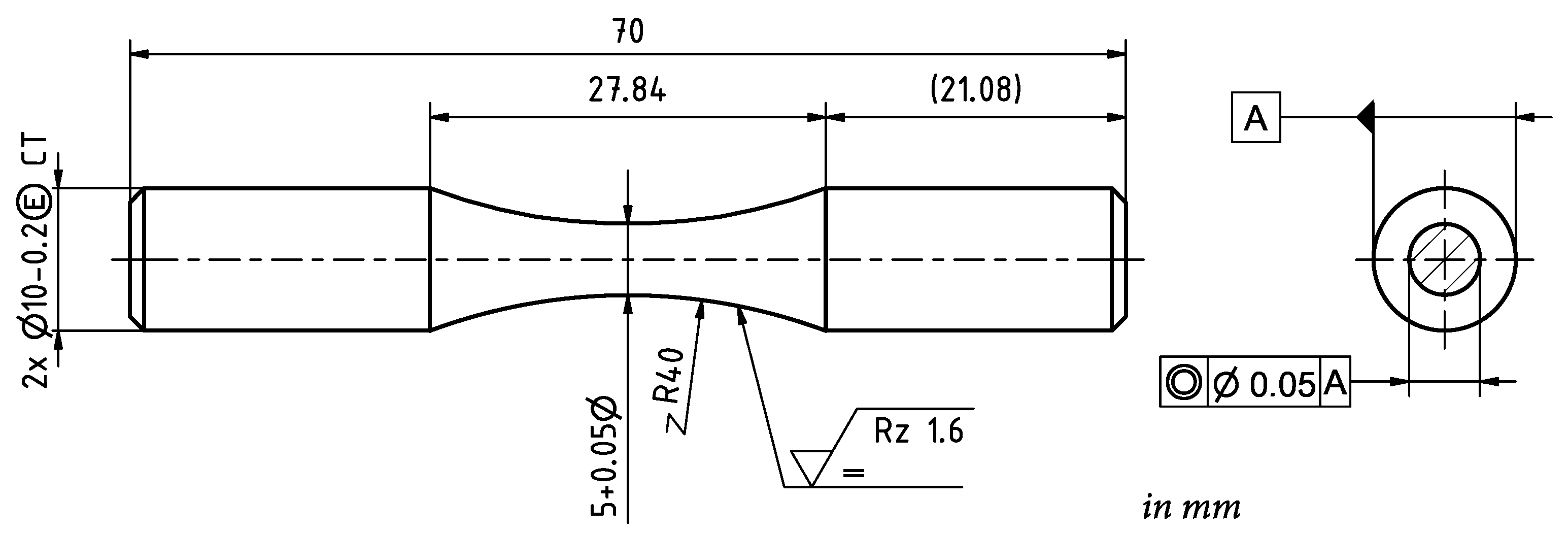
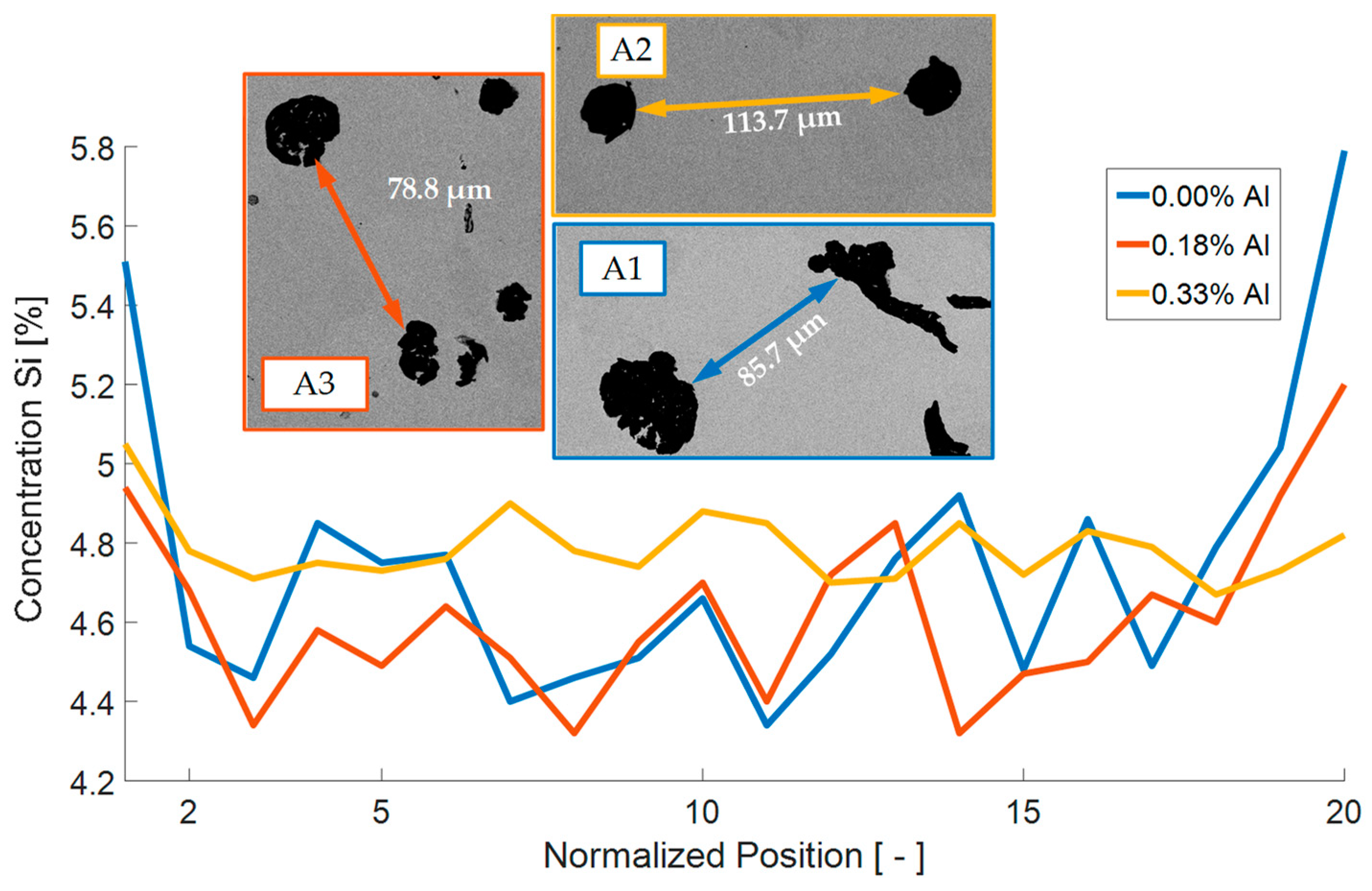
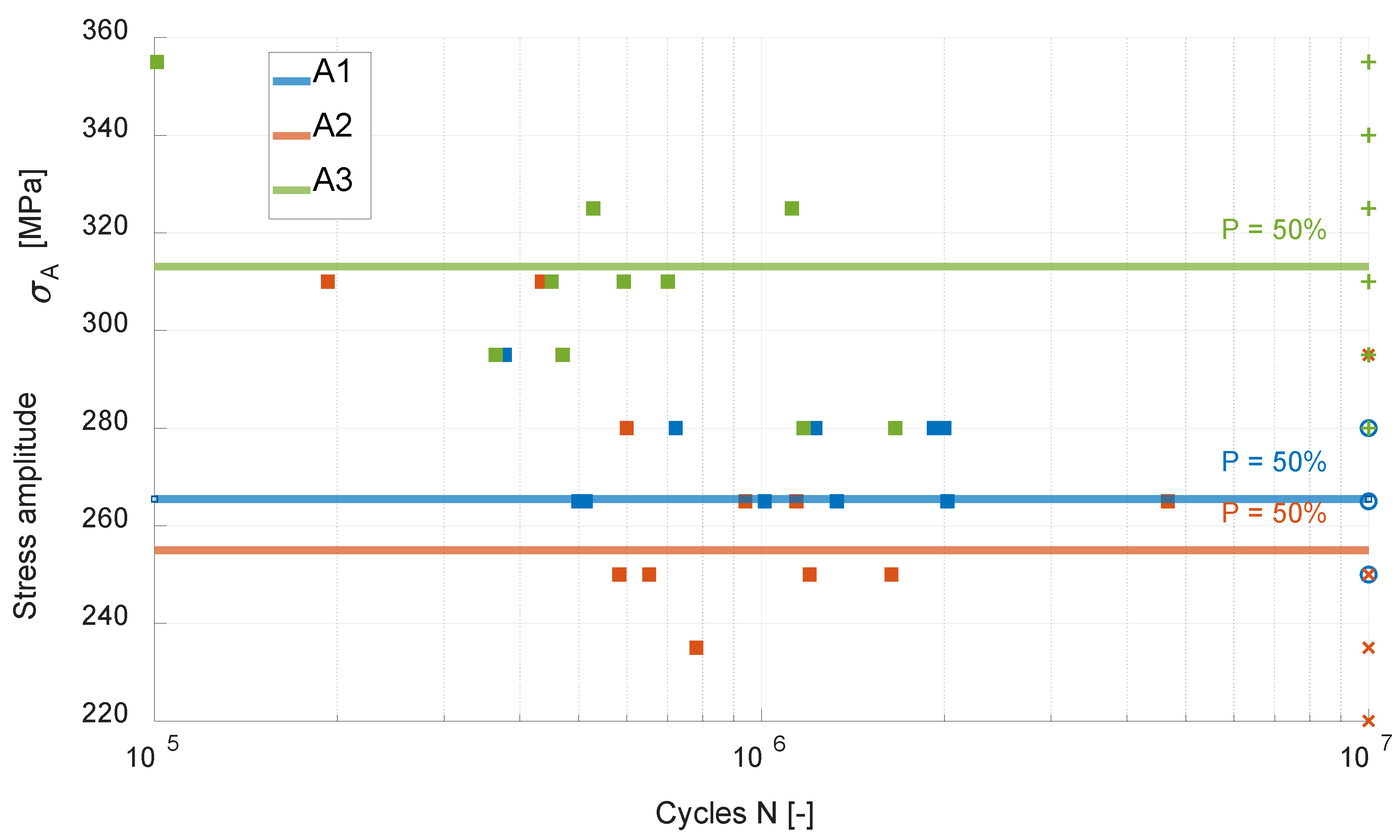
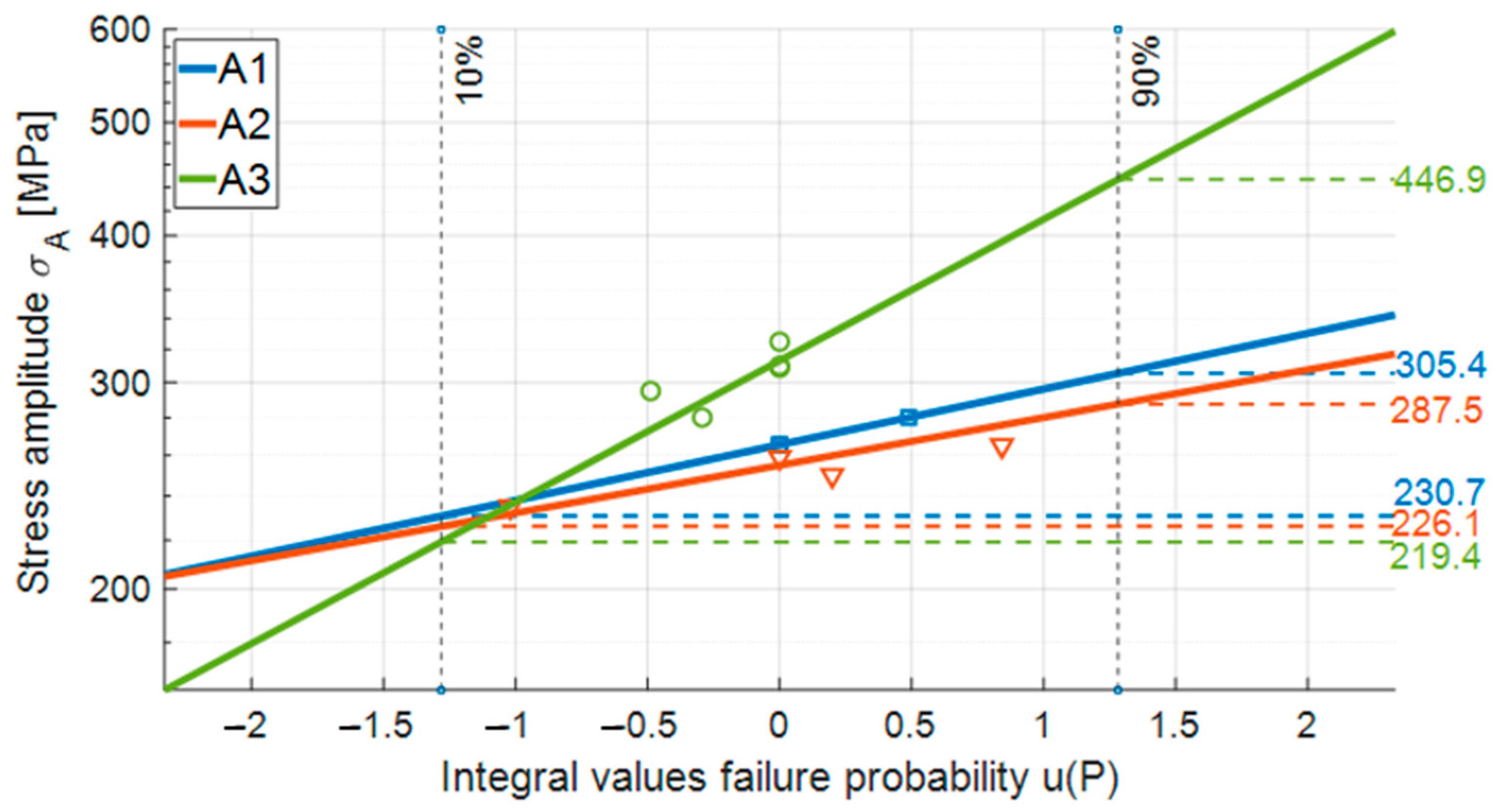
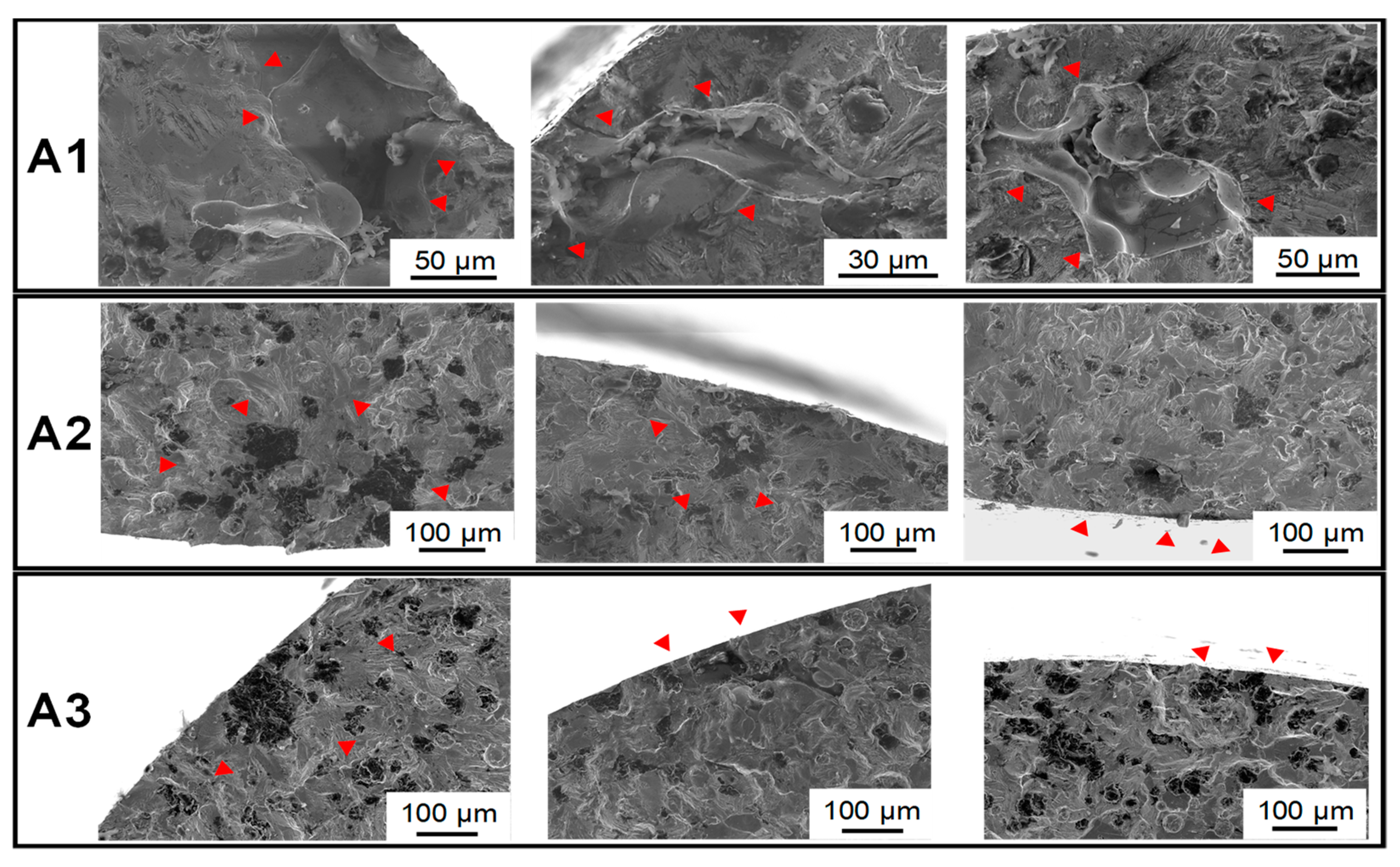
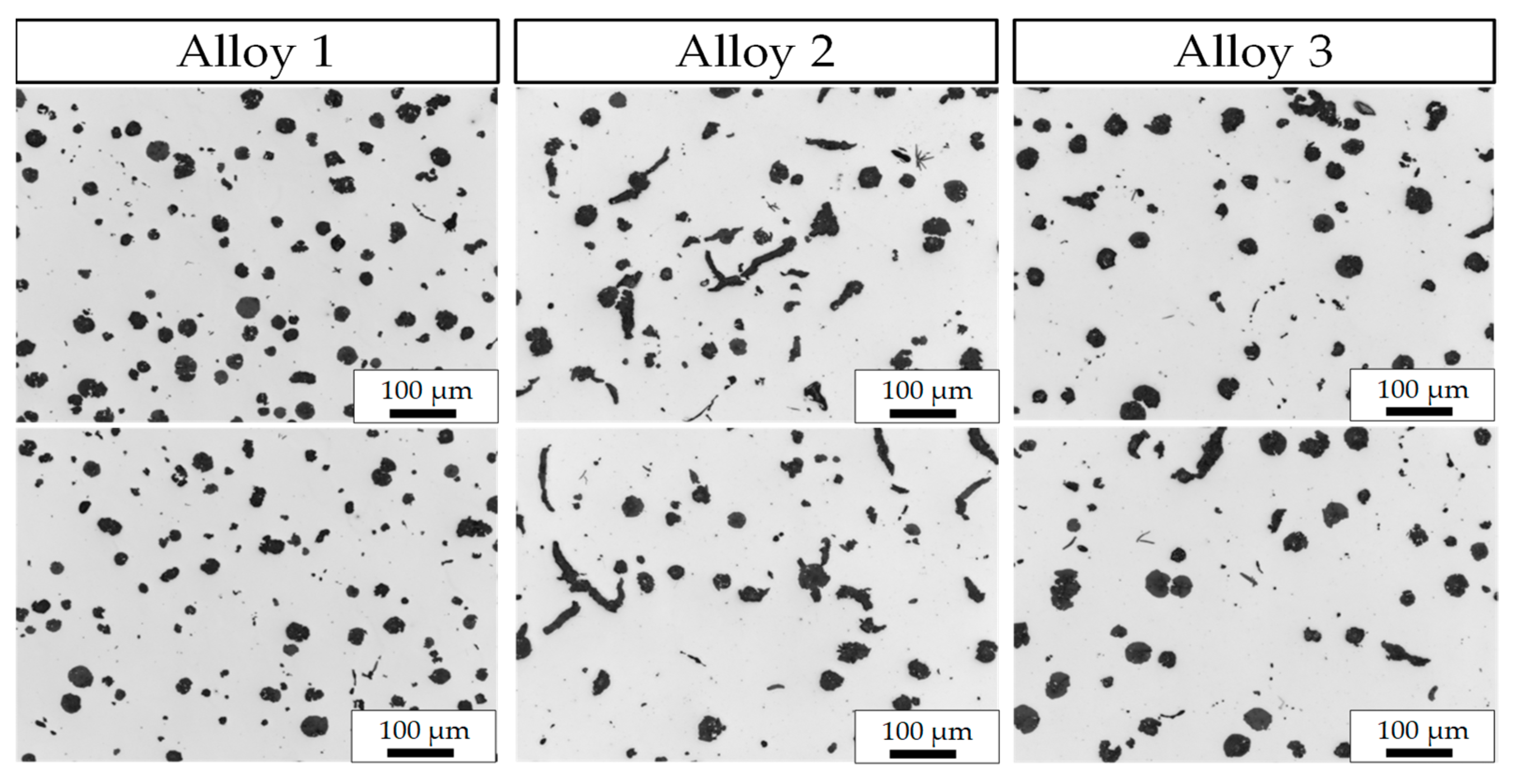
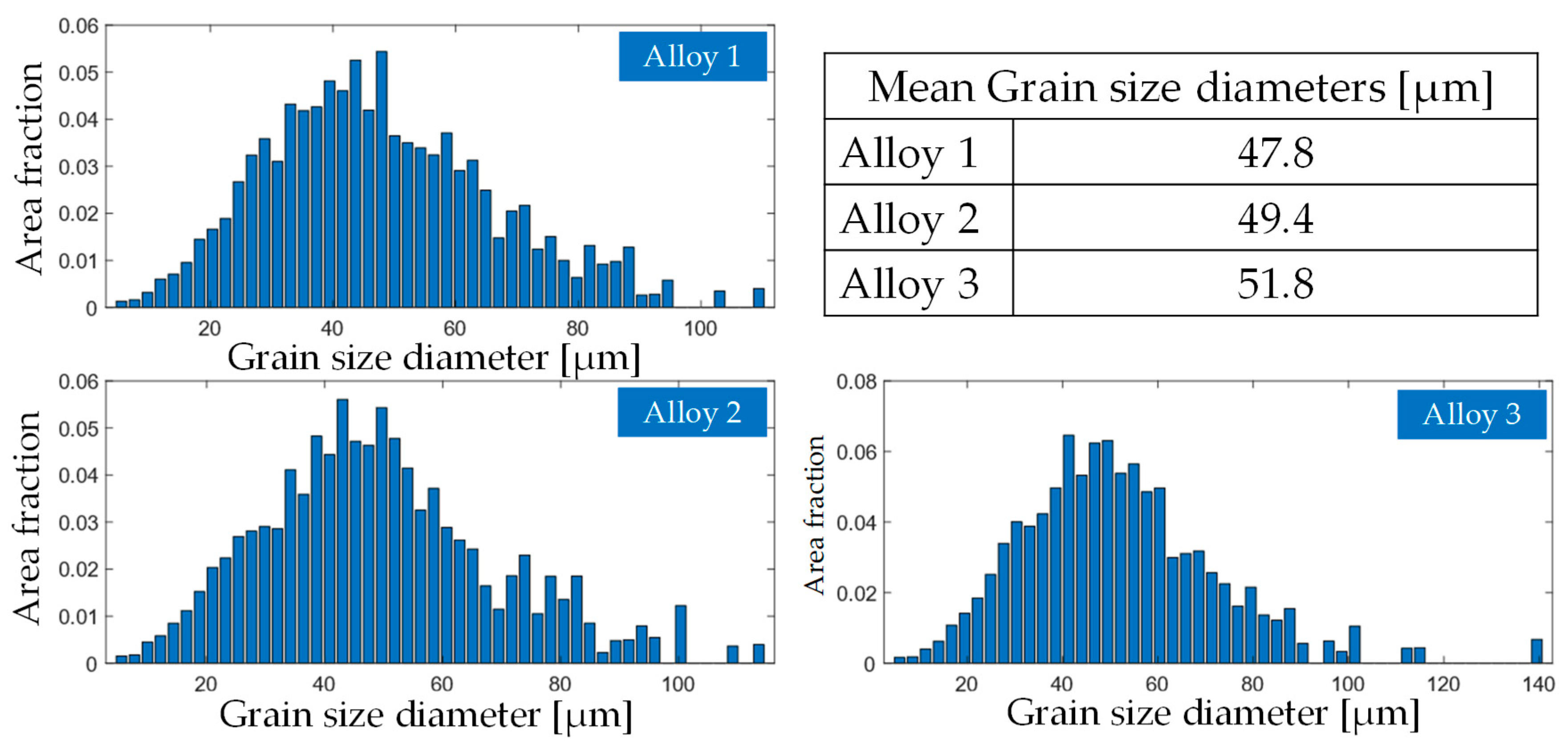

| Alloy | Carbon | Silicon | Aluminum | Magnesium | Carbon Equivalent (CE) |
|---|---|---|---|---|---|
| A1 | 2.77 | 4.33 | 0.00 | 0.068 | 4.21 |
| A2 | 2.77 | 4.26 | 0.33 | 0.068 | 4.19 |
| A3 | 2.68 | 4.49 | 0.18 | 0.059 | 4.18 |
| Alloy | Nodularity DIN [%] | Nodularity ASTM [%] | Nodule Count [1/mm2] |
|---|---|---|---|
| A1 | 74.4 | 86.0 | 75.3 |
| A2 | 43.8 | 73.0 | 54.1 |
| A3 | 58.7 | 78.2 | 50.6 |
Publisher’s Note: MDPI stays neutral with regard to jurisdictional claims in published maps and institutional affiliations. |
© 2021 by the authors. Licensee MDPI, Basel, Switzerland. This article is an open access article distributed under the terms and conditions of the Creative Commons Attribution (CC BY) license (http://creativecommons.org/licenses/by/4.0/).
Share and Cite
Gebhardt, C.; Nellessen, J.; Bührig-Polaczek, A.; Broeckmann, C. Influence of Aluminum on Fatigue Strength of Solution-Strengthened Nodular Cast Iron. Metals 2021, 11, 311. https://doi.org/10.3390/met11020311
Gebhardt C, Nellessen J, Bührig-Polaczek A, Broeckmann C. Influence of Aluminum on Fatigue Strength of Solution-Strengthened Nodular Cast Iron. Metals. 2021; 11(2):311. https://doi.org/10.3390/met11020311
Chicago/Turabian StyleGebhardt, Christian, Johannes Nellessen, Andreas Bührig-Polaczek, and Christoph Broeckmann. 2021. "Influence of Aluminum on Fatigue Strength of Solution-Strengthened Nodular Cast Iron" Metals 11, no. 2: 311. https://doi.org/10.3390/met11020311
APA StyleGebhardt, C., Nellessen, J., Bührig-Polaczek, A., & Broeckmann, C. (2021). Influence of Aluminum on Fatigue Strength of Solution-Strengthened Nodular Cast Iron. Metals, 11(2), 311. https://doi.org/10.3390/met11020311






